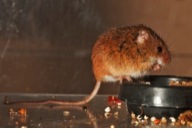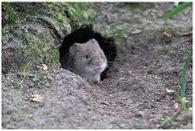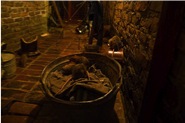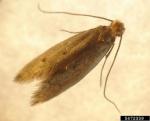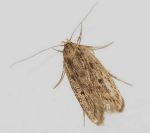How to identify members of the rodent or bird family that may find solace in your collection’s facility.
- Common mammals that infest archival institutions
- Mice
- Voles
- Rats
- Pigeons
House Mouse
- Found worldwide, they travel the world via trade routes on boats
- They prefer warmer climates
- Signs of infestation include feces; urine; stains on textiles, holes in textiles, leathers, wood, paper, and anything else they can use to make a nest
- Identification: 5-8 inches long, with a long tail, furry, light brown in colour, with large ears
- Feeds on leftover food, insects, plants, antler and cellulose plastics
- Average lifespan is 1-2 years
- The best form of control is to seal off any hole 6 mm or larger in the collection’s facility, including around windows, doorframes, and the foundation, with a material like copper gauze that mice can’t chew through
- Their presence could indicate a larger issue of an insect infestation
Voles
- Found in meadows, fields, and prairies
- They prefer underground burrows with thick grass
- They do not infest buildings, but their presence could promote other pests to move in
- Identification: 5-8 inches long, furry, dark grey brown in colour, with smaller ears than a mouse
- They scavenge for food including scraps and vegetation
- Average lifespan is 2-16 months
- The best form of control is removing vegetation in close proximity to the collection’s facilities
Rats
- Rats are uncommon in Alberta, due to its province wide rat control program, but they are common in the rest of the world
- They prefer warmer climates, and must live within heated buildings
- Signs of infestation include oily marks on the wall; feces; crumbs; holes in wood, textiles, leather and other things used to make their nests
- Identification: 13-18 inches long, very long tail, furry, brown, black or yellowy white in colour
- They scavenge for leftover food
- Average lifespan is 1 year, but they can live for 3 years
- The best form of control is to seal holes with a metal or concrete filling, cleaning often, ensuring garbage bins have lids, and putting metal grates on vents and drainage pipes
Pigeons
- They are found worldwide from temperate, tropics, to the arctic
- They prefer manmade environments like large cities
- Signs of infestation include droppings on buildings and statues, feathers, and nests
- Identification: They around 11 inches long with large bodies and smaller heads, and the colours they sport range from blue-grey, grey, black, and white
- They need open water to survive, and they eat scraps, seeds, grains, grass, and berries
- Average lifespan is 3-5 years
- They won’t affect a collection, but their food scraps, nests, and droppings will attract other pests like insects to the area
- The best form of control is keeping the grounds around the facility clean, and putting bird spikes on roof ledges to deter pigeons from nesting there.
The information on rodents and birds discussed in this blog post are summarized from the Identification webpage by MuseumsPests.net. Please refer to their site for more information.
